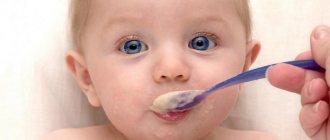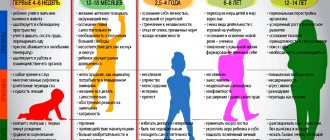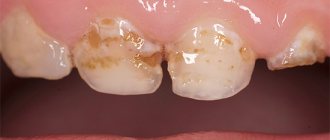Regurgitation of food that was eaten after feeding
What is regurgitation? This is a reflexive ejection of minor stomach contents into the esophagus, then into the pharynx and oral cavity. It occurs repeatedly in children, even at an early age. Statistics show that 67% of babies under 4 months burp at least once a day. However, many parents worry about spitting up during or after feeding. In general, regurgitation is a natural process that occurs independently. There is no need to worry if the baby grows and gains weight for no reason, but we should not forget that regurgitation can also mean various diseases, then measures must be taken. In this case, you should consult a doctor.
How should you help the baby in this case? It is necessary to avoid excessive feeding, rapid sucking and swallowing air. It is necessary to pay attention to the fact that the baby holds both the nipple and the areola; in this case, the baby’s swallowing of air will be minimal. It is also recommended to monitor the bottle when feeding so that the nipple is completely filled with milk and no air gets in there; to do this, you need to tilt the bottle at an angle. It is recommended to use nipples with air valves or regular ones with medium-sized holes. It is recommended to keep the baby in a semi-upright position while feeding. It is also recommended to feed the baby with short breaks of 5 minutes; during this break, you need to turn the baby facing you and keep him in an upright position, after which you can continue feeding. Often babies suck on their own at intervals. Doctors recommend feeding your baby more often, but in smaller amounts. You should avoid feeding your baby while crying. After feeding, it is necessary to keep the baby in an upright position so that he can burp up air. In order to avoid regurgitation, before feeding the baby, you need to place him on his tummy and stroke the tummy around the navel with your palm clockwise. After feeding, there is no need to stir or change the baby. It is also necessary to pay attention to the fact that so that during feeding the baby’s nose does not rest on the chest, for this it is necessary to press the index finger on the chest in front of the nose. It is also necessary to constantly clean the spout cavity. If your baby has a runny nose, you need to use nasal drops.
Infectious diseases in children
Almost every child, from the moment of his socialization (usually at 2-3 years), and sometimes during infancy, is faced with infections that mainly affect children. The so-called childhood infections are combined into a separate group of diseases that spread quite quickly and can cause local outbreaks or epidemics among the young population. A feature of childhood infections is the acquisition of stable (up to lifelong) immunity in a child who has recovered from the disease. At the same time, the course of the disease in adults, if they did not suffer an infectious infection in childhood, is much more severe.
The group of childhood infections differs in the way they are transmitted only from a sick person to a healthy person, so there is a very high probability of children quickly becoming ill in schools and kindergartens, and in other places where children actively visit (theaters and New Year trees, other holiday events). An important measure to prevent the spread of infections among children is a set of vaccinations carried out in accordance with a certain schedule for different age groups. Vaccination measures significantly reduce the epidemic burden, but all parents should know the methods of spread, symptoms and types of childhood infectious diseases.
Distribution mechanism
Even accidental contact of a child with a sick person can cause him to develop some kind of infectious disease. Children's infections have an aerogenic mechanism of infection, when the disease spreads not only through coughing and sneezing, but even during talking or laughing. The pathogen is transferred with tiny particles of saliva and air exhaled by an infected child, directly reaching healthy babies located within a radius of 2-3 meters. Some childhood infections have the ability to spread over longer distances, regardless of air temperature (measles pathogens can cover the entire building through the ventilation system and elevator shafts).
No less dangerous is the household route of transmission, when the pathogen gets from a sick child onto various objects (toys and dishes, books and towels, other things), which are subsequently used by healthy children. The most resistant pathogens (diphtheria and scarlet fever) have a high survival rate on household objects, which contributes to the development of outbreaks of these diseases. It is also necessary to take into account the oral-fecal method of spread of childhood infections, in which the pathogen is transmitted through unwashed hands (poliomyelitis and intestinal infections).
Symptoms of childhood infections
The symptoms of childhood infections have similar characteristics, so qualified treatment requires differentiated diagnostics carried out in laboratory conditions by medical institutions. The following manifestations are considered characteristic symptoms of infectious diseases in children:
- febrile state with fibril temperature;
- rashes on the torso, limbs and face of the child (the nature of the rash varies from small with a reddish tint to spotty with a brownish tint, as well as with the formation of papules and weeping wounds);
- inflammation and swelling of the salivary glands located near the ears;
- coughing attacks with severe spasms or a barking sound;
- general weakness, lack of appetite;
- wheezing and inflammation of the nasopharynx with pain when swallowing and hoarseness;
- inflammation of the oral mucosa and the development of conjunctivitis;
- intestinal disorders due to intoxication of the body.
Types of childhood infections
The classification of childhood infections includes the following main diseases:
- measles with an incubation period of up to 3 weeks and characteristic rashes significantly reduces the child’s immunity, contributing to the development of bronchopulmonary complications, otitis media and stomatitis;
- mumps (viral mumps) with an incubation period of up to 26 days is dangerous for the development of meningitis, damage to the central nervous system and pancreas, as well as reproductive organs in boys;
- rubella with an incubation period of up to 3 weeks affects the cervical and occipital lymph nodes;
- diphtheria with an incubation period of up to 10 days is characterized by a critically high temperature, severe soreness in the throat and abdomen, and the threat of suffocation;
- scarlet fever with an incubation period of up to a week and development in complicated cases of nephritis, otitis and lymphadenitis;
- chickenpox with an incubation period of up to 3 weeks and persistent rashes throughout the body;
- polio with an incubation period of up to 2 weeks and complications in the form of irreversible paralysis of the limbs;
- intestinal infections (myocarditis and meningitis, tonsillitis) with the occurrence of severe complications.
The basis for success in the treatment of childhood infections is accurate diagnosis with identification of the pathogen, which is possible only in a well-equipped laboratory. By contacting the Baltic Children's Medical Center, infected children receive effective treatment using the latest technologies.
Physiological conditions of newborns: normal or pathological?
Home Articles Popular information articles Our children
Neonatology in medical institutions of Chelyabinsk:
Maternity hospital of the South UGMU clinic Maternity hospital of the City Clinical Hospital No. 8 Maternity hospital of the City Clinical Hospital No. 9
When a little person is born, he experiences enormous stress. It passes through the birth canal, which in itself is not easy, and the birth may not be entirely successful. Then the newborn finds himself in a world where it is not as comfortable as in his mother’s belly. Therefore, during adaptation to the environment, the child may experience so-called “physiological states”. They are also called transitional, as they reflect the baby’s transition from intrauterine to extrauterine life. All these conditions are temporary and disappear with the end of the neonatal period (during the first month of life) and do not require treatment. Nevertheless, young mothers may be concerned about changes in the baby’s condition, so it is important to be able to distinguish the physiological conditions of the newborn from the onset of the disease.
CARE FOR A CHILD UP TO ONE YEAR OF AGE
Weight loss
On the 2-3rd day of a baby’s life, his weight decreases by 5-10 percent of his birth weight - this is a physiological loss of body weight. After all, in utero the baby received all the nutrients from the mother’s blood through the umbilical cord. To make adaptation to a different type of nutrition more favorable for the baby, early breastfeeding is recommended (in the first 30 minutes after birth). By 6-7 days the baby regains its original weight.
Transient fever
Simultaneously with physiological weight loss, a transient fever occurs in the newborn on the 3rd-4th day of life. There are several reasons for this transitional state. This is an insufficient intake of fluids into the child’s body (at this time the baby still receives colostrum, which is much thicker than “mature” milk and contains a large amount of protein). Also, the baby’s thermoregulation system has not yet been adjusted and the skin evaporates more fluid than the body receives from food and drink. The result is dry skin, mucous membranes and general dehydration of the body.
A transient fever manifests itself with an increase in body temperature to 38-40 degrees, the child becomes excited and restless. This condition lasts 1-2 days, and then the temperature returns to normal.
Antipyretic drugs have no effect for transient fever. Treatment consists of feeding the baby (you can give warm boiled water or saline) and creating a comfortable temperature and humidity. It is important that the child does not overheat or become hypothermic (you can use a humidifier).
Uric acid infarction
On the 5th-6th day of a newborn’s life, the mother may notice that the baby’s urine has become cloudy and orange-brown in color, and reddish spots remain on the diaper. This physiological condition is called uric acid infarction. It is associated with immaturity of metabolism, increased formation of uric acid and its salts and increased excretion in the urine.
Uric acid infarction resolves spontaneously as fluid intake (including breast milk) increases by 10-12 days of the baby’s life.
Physiological jaundice
This transitional state manifests itself in most newborns from 2-3 days of life - the skin becomes jaundiced; With physiological jaundice, stool and urine do not change color; the sclera does not turn yellow. The reasons for this condition are the enzymatic immaturity of the liver, which is not yet able to cope with the processing and excretion of bilirubin; it accumulates in the body, giving a yellow color to the skin. In order for bilirubin metabolism to normalize, it takes 1-2 weeks, so physiological jaundice “disappears” by the 10-4th day of life and does not require treatment.
At this time, the child’s well-being, as a rule, does not suffer. Jaundice that appears in the first days after birth, rapidly progresses and lasts longer than 14-16 days may indicate a serious deviation in the baby’s health. In any case, if there is anything alarming about the color of your child’s skin, regardless of age, be sure to consult your pediatrician.
Erythema of the newborn
This physiological condition is characterized by redness of the skin after removal of vernix lubrication by the end of the first day after birth. It is also called physiological catarrh and can intensify for 2-3 days. Erythema usually subsides by 4-5 days of life, followed by peeling. This does not affect the baby’s well-being in any way.
Sometimes it is possible to develop toxic erythema on days 4-5 of life. A rash appears on the skin in the form of small red spots and bumps, and bubbles with transparent contents may also appear on bright red inflamed skin. Toxic erythema is the result of an allergic reaction of the child’s body to environmental factors. It is important to prevent further development of toxic erythema: for this you need to ensure maximum cleanliness. Do not lubricate or open blisters on the skin - this will lead to the development of purulent inflammation. Under favorable and comfortable conditions for the baby, toxic erythema disappears on its own after 2-3 days.
Sexual crisis
In utero, the baby receives the mother's hormones through the placenta - estrogens, which are necessary for the proper development of the baby. After birth, the child no longer receives them. Visible changes in girls occur in estrogen-dependent organs: mammary glands, vagina and uterus, although manifestations of a sexual crisis are observed in children of both sexes.
The mammary glands increase in volume from 2-4 days of life and reach maximum engorgement by 7-8 days. Breast engorgement is always bilateral, symmetrical, the color and temperature of the skin near the nipples do not change, the mammary glands can increase up to 3 cm in diameter. Breast engorgement usually disappears by 2-3 weeks of life, sometimes it can persist until one month of age. This condition does not require treatment.
On the 3rd-4th day of life, newborn girls experience grayish-white discharge from the genital tract - this is the exfoliation of a large number of vaginal epithelial cells. They disappear in the second week of life. This condition also does not require treatment. You just need to wash the girl several times a day from front to back (that is, hold the child with her tummy up so that the water washes first the genitals and then the buttocks). You should not try to remove all the mucus from the genital slit, the main thing is that there are no excessive accumulations. It is important to follow the rules of hygiene when caring for a newborn girl, otherwise an infection may also occur. In case of heavy and prolonged bleeding, additional examination is necessary to exclude the disease. On the contrary, the absence of manifestations of a sexual crisis (vaginal discharge) may indicate a fusion of the labia in the baby. Therefore, any deviation from the physiological norm, any doubt a mother has about her baby must be resolved by a pediatrician.
In boys, on the 3-4th day of life, the appearance of the genital organs changes: the scrotum becomes swollen and increased in volume. By 7-8 days, these manifestations usually fade away, although in some cases the genitals take on normal size only by the age of one month. These changes do not require anything other than ordinary hygiene.
In a newborn baby, you can notice whitish-yellow rashes on the face - this is a consequence of blockage of the excretory ducts of the sebaceous glands, which work most actively during a sexual crisis. The rash is called milia and can be located on the forehead, wings of the nose, or chin. After a few days, the milia disappear on their own and do not cause concern to the baby.
As you can see, there are many physiological conditions in newborns, and most of them appear at the same time - on the 2-4th day of the baby’s life. It is in your power to provide your child with the greatest possible comfort, cleanliness, compliance with all hygienic rules of care and, of course, breastfeeding. Then your baby will easily and quickly adapt to the world around him.
Author: T.V. Karikh, pediatrician at HCMP.
Based on materials from the newspaper “On Health” (issue No. 5, May 2009)
Print version
Colic
Colic can occur both in the normal state of the body and in various diseases. In most cases, babies suffer from gas formation between three weeks and three months. Mostly babies suffer when breastfed, especially when artificial, but symptoms can appear either immediately or after some time. It manifests itself in the baby through anxiety, screaming, pressing the legs to the tummy and refusal of the breast. The duration of colic is from several minutes to a couple of hours, and can also be repeated every day. In most cases, the causes of colic may be inappropriate milk formula, food allergies, constipation, overfeeding, flatulence, aerophagia (excessive swallowing of air), or a violation of the diet of the nursing mother. If there is a lack of lactose in the baby’s intestines, the amount of lactose decreases, i.e. an enzyme that processes lactose saccharides found in milk. As a result, the processes of fermentation and excessive release of gases begin in the baby’s intestines, the tummy also swells and rumbling is heard in it, the stool becomes liquefied with an excessive content of gases. Also, colic can occur due to poor nutrition of a nursing mother; even during discharge from the maternity hospital, doctors explain how to eat after childbirth. Let us remind you that it is contraindicated to eat pea soup, brown bread, bright fruits, cabbage, legumes, fresh vegetables, carbonated drinks, etc.
If your baby has colic, you should put the baby on his tummy, massage the tummy in a clockwise circular motion, or put a warm diaper on his stomach, ironing it first. It is also recommended to use herbal teas, but only those that are suitable for the baby’s age. You can use special therapeutic milk formulas for artificial nutrition. In order for the baby to be distracted from colic, it is recommended to turn on the fan, monotonous music, and take a walk.
Colic in a baby is quite a common occurrence, which can be avoided by consulting a doctor who will prescribe medications that reduce gas in the baby’s tummy.










